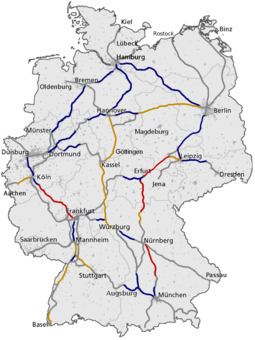 | ||
Construction of the first German high-speed rail lines began shortly after that of the French LGVs (lignes à grande vitesse , high speed lines). However, legal battles caused significent delays, so that the German InterCityExpress (ICE) trains were deployed ten years after the TGV network was established.
Contents
InterCityExpress
The first regularly scheduled ICE trains ran on 2 June 1991 from Hamburg-Altona via Hamburg Hbf – Hannover Hbf – Kassel-Wilhelmshöhe – Fulda – Frankfurt Hbf – Mannheim Hbf and Stuttgart Hbf toward München Hbf on the new ICE line 6. The ICE network is more tightly integrated with pre-existing lines and trains as a result of the different settlement structure in Germany , which has almost twice the population density of France. ICE trains reached destinations in Austria and Switzerland soon after they entered service, taking advantage of the same voltage used in these countries. Starting in 2000, multisystem third-generation ICE trains entered the Netherlands and Belgium. The third generation of the ICE has a service speed of 330 km/h (205 mph) and has reached speeds up to 363 km/h (226 mph).
Admission of ICE trains onto French LGVs was applied for in 2001, and trial runs completed in 2005. Since June 2007, ICEs service Paris from Frankfurt and Saarbrücken via the LGV Est.
Unlike the TGV in France or Shinkansen in Japan, Germany has experienced a fatal accident on a high-speed service. In the Eschede train disaster of 1998, a first generation ICE experienced catastrophic wheel failure while travelling at 200 km/h near Eschede, following complaints of excessive vibration. Of 287 passengers aboard, 101 people died and 88 were injured in the resulting derailment. The accident was the result of faulty wheel design and, following the crash, all ICE wheels of that design were redesigned and replaced.
Thalys trains began running in Germany in 1997, from the Belgian HSL 3 to Aachen and Cologne using the Cologne–Aachen high-speed railway. TGV POS trains began running in Germany in 2007, to Karlsruhe and Stuttgart using the Mannheim–Stuttgart and Karlsruhe–Basel high-speed lines.
Transrapid
Germany has developed the Transrapid, a magnetic levitation train system. The Transrapid reaches speeds up to 550 km/h (340 mph). A test track with a total length of 31.5 km (19.6 mi) operated in Emsland until Early 2012, when it was closed and dismantled. In China, Shanghai Maglev Train, a Transrapid technology based maglev built in collaboration with Siemens, Germany, has been operational since March 2004.
Upgraded Line
Partially New Line
Part of these routes are new constructions that run along or close to the existing, or previous, route:
Fully New Line
Completely new construction projects:
